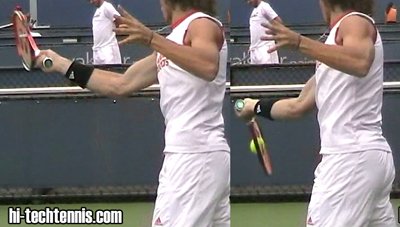I went out to Queens today and watched some Qualies as well as some practice sessions. Saw Scoville Jenkins playing McClure (both American), sawa Swiss guy named Michael Lammer or Lamner(?) playing Inigo Cervantes (ESP). That looked like the best quality tennis among the Qualies.
Saw a bunch of women playing who I didn't recognize.
Watched Haas & Lapenti play a practice set. Haas lost the tiebreaker, and sent 2 balls out of the grandstand stadium. Later, saw Lapenti playing Fernando Gonzalez.
Saw Del Potro hitting, and then Robredo as well.
Saw a woman who I think was Spanish or Italian on the outer courts just lambasting her backhand (one-hander). It was a sight to behold. She was practicing w/ a new-name player. Culko? (I think I have that wrong--a long-blond-haired small woman who was on TV for the first time at Wimbledon or the French and almost upset Sharapova maybe?)
Of all I saw, though, the most impressive thing (besides maybe the woman's one-hander) was Juan Monaco practicing. His forehand was noticably quicker through the hitting zone than anyone else's. The chain from feet to hips to shoulders, to elbow to wrist to racquet head was cleaner, faster, clearer than anyone else's. (I've seen him play before at the Open and never saw this going on before.)
It actually alerted me to something that I'd only been cloudily considering before and that is this: the possibility that the double-bend forehand has something going on in it that is subtle and not completely obvious. (Duh!) When I watched Monaco it looked like the elbow was actually functioning as a fulcrum from which the forarm accelerated along a new, complementary arc...a sort of launch point for the acceleration of the next link the kinetic chain...and the wrist, because it is laid back, then launches the acceleration of the next link (the racquet) along a new, and once again complementary circle.
Put slightly differently, the double bend (I speculate) may accentuate the acceleration of racquet head speed along a non-linear path. More specifically, the path of the racket head is moving both along a horizontal arc as well as along an oblique arc (low to high). The oblique arc is achieved, at least in part, as a function of the shoulder's and forarm's progression from supination to pronation. The contribution made to the vertical component of the oblique arc made by the supination/pronation progression may be accentuated by the double bend hitting structure.
That's what I'm trying to get at. Again: The contribution made to the vertical component of the oblique arc made by the supination/pronation progression may be accentuated by the double bend hitting structure.
I'll try to make a sketch of what I mean, for consideration. I may be all wet on this, but I suspect that there's something in here worth mining.
Saw a bunch of women playing who I didn't recognize.
Watched Haas & Lapenti play a practice set. Haas lost the tiebreaker, and sent 2 balls out of the grandstand stadium. Later, saw Lapenti playing Fernando Gonzalez.
Saw Del Potro hitting, and then Robredo as well.
Saw a woman who I think was Spanish or Italian on the outer courts just lambasting her backhand (one-hander). It was a sight to behold. She was practicing w/ a new-name player. Culko? (I think I have that wrong--a long-blond-haired small woman who was on TV for the first time at Wimbledon or the French and almost upset Sharapova maybe?)
Of all I saw, though, the most impressive thing (besides maybe the woman's one-hander) was Juan Monaco practicing. His forehand was noticably quicker through the hitting zone than anyone else's. The chain from feet to hips to shoulders, to elbow to wrist to racquet head was cleaner, faster, clearer than anyone else's. (I've seen him play before at the Open and never saw this going on before.)
It actually alerted me to something that I'd only been cloudily considering before and that is this: the possibility that the double-bend forehand has something going on in it that is subtle and not completely obvious. (Duh!) When I watched Monaco it looked like the elbow was actually functioning as a fulcrum from which the forarm accelerated along a new, complementary arc...a sort of launch point for the acceleration of the next link the kinetic chain...and the wrist, because it is laid back, then launches the acceleration of the next link (the racquet) along a new, and once again complementary circle.
Put slightly differently, the double bend (I speculate) may accentuate the acceleration of racquet head speed along a non-linear path. More specifically, the path of the racket head is moving both along a horizontal arc as well as along an oblique arc (low to high). The oblique arc is achieved, at least in part, as a function of the shoulder's and forarm's progression from supination to pronation. The contribution made to the vertical component of the oblique arc made by the supination/pronation progression may be accentuated by the double bend hitting structure.
That's what I'm trying to get at. Again: The contribution made to the vertical component of the oblique arc made by the supination/pronation progression may be accentuated by the double bend hitting structure.
I'll try to make a sketch of what I mean, for consideration. I may be all wet on this, but I suspect that there's something in here worth mining.






Comment